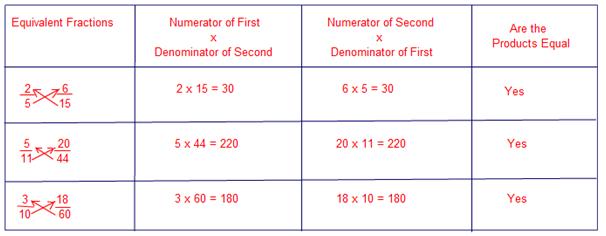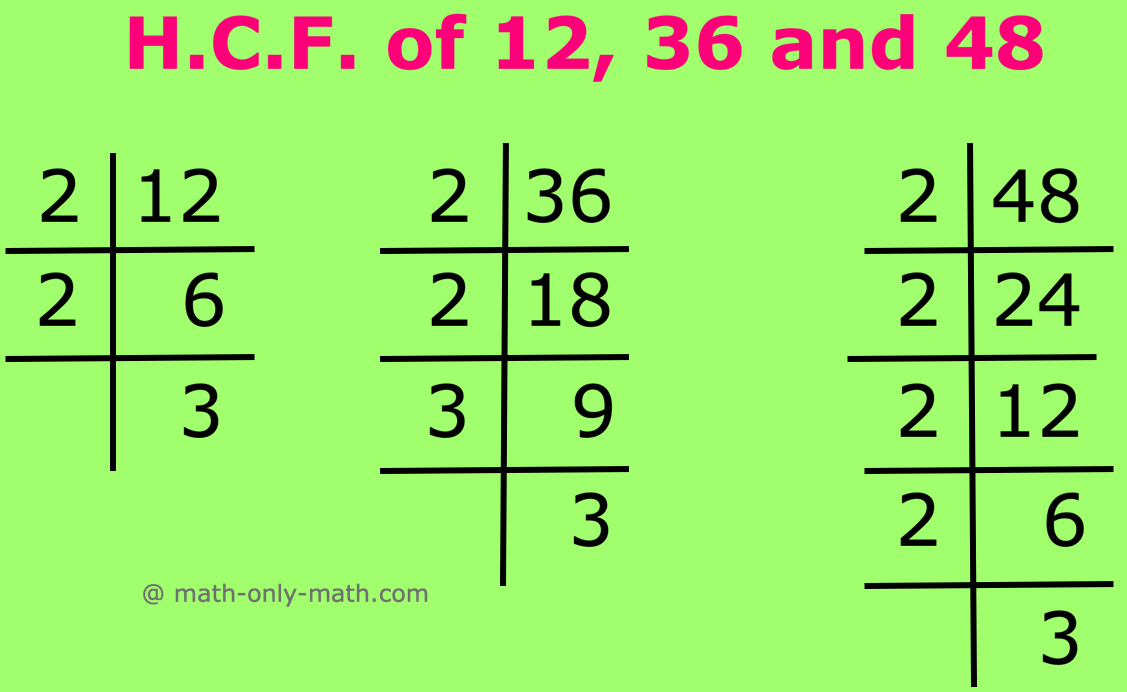Interesting Fact about Equivalent Fractions
There is an interesting fact about equivalent fractions is shown in the following table.
The product of the numerator of the first fraction and the denominator of the second fraction is equal to the product of the denominator of the first fraction and the numerator of the second fraction.
We can check whether two fractions are equivalent or not by cross multiplication i.e. we multiply the denominator of the second fraction with the numerator of first fraction and the denominator of the first fraction with the numerator of the second fraction. The given fractions are equivalent, if the two products are equal otherwise not.
For Example:
Check whether the given fractions are equivalent:
(i) ⁵/₁₁, ¹⁵/₃₃
By cross-multiplication, we have
5 × 33 = 165 and 11 × 15 = 165
Since the two products are same, so the given fractions are equivalent.
(ii) ²/₅, ⁴/₁₀
By cross-multiplication, we have
2 × 10 = 20 and 5 × 4 = 20
Since the two products are same, so the given fractions are equivalent.
(iii) 5/7, 20/18
By cross-multiplication, we have
5 × 18 = 90 and 7 × 20 = 140
Since the two products 90 and 140 are not same, so the given fractions are not equivalent.
(iv) ⁶/₁₁, ³/₄
By cross-multiplication, we have
6 × 4 = 24 and 11 × 3 = 33
Since the two products 24 and 33 are not same, so the given fractions are not equivalent.
● Fraction
Representations of Fractions on a Number Line
Conversion of Mixed Fractions into Improper Fractions
Conversion of Improper Fractions into Mixed Fractions
Interesting Fact about Equivalent Fractions
Addition and Subtraction of Like Fractions
Addition and Subtraction of Unlike Fractions
Inserting a Fraction between Two Given Fractions
Number Page
6th Grade Page
From Interesting Fact about Equivalent Fractions to HOME PAGE
Recent Articles
-
Divisible by 3 | Test of Divisibility by 3 |Rules of Divisibility by 3
Mar 26, 25 11:08 AM
A number is divisible by 3, if the sum of its all digits is a multiple of 3 or divisibility by 3. Consider the following numbers to find whether the numbers are divisible or not divisible by 3: (i) 54… -
Worksheet on 14 Times Table | Printable Multiplication Table | Video
Mar 25, 25 11:41 PM
Worksheet on 14 times table can be printed out. Homeschoolers can also use these multiplication table sheets to practice at home. -
5th Grade Relation Between HCF and LCM | Solved Examples | Worksheet
Mar 25, 25 10:23 AM
Here we will discuss about the relationship between hcf and lcm of two numbers. Product of two numbers = Product of H.C.F. and L.C.M. of the numbers. Solved Examples on 5th Grade Relation Between HCF… -
5th Grade Least Common Factor (LCM) | Factorization & Division Method
Mar 25, 25 02:39 AM
We already familiar with the least common multiple which is the smallest common multiple of the numbers. The least (lowest) common multiple of two or more numbers is exactly divisible by each of the g… -
5th Grade Highest Common Factor | HCF | GCD|Prime Factorization Method
Mar 24, 25 11:58 PM
The highest common factor (H.C.F.) of two or more numbers is the highest or greatest common number or divisor which divides each given number exactly. Hence, it is also called Greatest Common Divisor…






New! Comments
Have your say about what you just read! Leave me a comment in the box below. Ask a Question or Answer a Question.